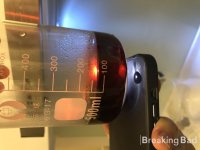William D.
Expert
- Joined
- Jul 19, 2021
- Messages
- 1,043
- Reaction score
- 1,280
- Points
- 113
Reagents:
Reaction scheme:
 Synthesis:
Synthesis:
- 1-Phenyl-2-nitropropene (P2NP; cas 705-60-2) 1.63 g, 10 mmol;
- Powdered iron (Fe) 3 g;
- FeCl3 0.6 g;
- Hydrochloric acid (HCl 36% aq.) conc. 4 ml;
- Toluene 15 ml;
- Water 55 ml;
- Hydrochloric acid 3N (10.45%) HCl 25 ml;
- Sodium bicarbonate (NaHCO3);
- Magnesium sulfate (MgSO4);
- Round bottom flask 50 ml;
- Retort stand and clamp for securing apparatus;
- Boiling chips;
- Reflux condenser;
- Glass rod and spatula;
- Separatory funnel;
- Heating plate;
- Laboratory grade thermometer;
- Laboratory scale (0.1-200 g is suitable);
- Measuring cylinder 20 mL;
- Funnel;
- Filter paper;
- Rotovap machine (optional);
- Vacuum source (optional);
- pH Indicator paper;
- Beakers 100 ml x2 and 200 ml;
Synthesis of 1-Phenyl-2-propanone (P2P) From 1-Phenyl-2-nitropropene (P2NP)
In this video I will be synthesising 1-phenyl-2-propanone from 1-phenyl-2-nitropropene. This...
1. A mixture of 1-phenyl-2-nitropropene (P2NP) 1.63 g, 10 mmol, powdered iron 3 g, FeCl3 0.6 g, and hydrochloric acid (HCl 36% aq.) concentrated 4 ml in toluene 5 ml and water 5 ml are stirred vigorously at 75 °C for 18 h in 50 ml flask with reflux condenser.
2. The resulting dark green suspension is cooled to room temperature and filtered. Layers are separated.
3. The aqueous layer is washed with an additional portion of toluene 10 ml, and toluene extracts are combined and washed with hydrochloric acid 3N (10.45%) HCl 25 ml, water 25 ml, saturated sodium bicarbonate (NaHCO3) aq. 25 ml, and water 25 ml successively to neutral pH 7.
4. The toluene solution is filtered and dried over anhydrous magnesium sulfate (MgSO4). Mixture is filtered from solids.
5. Toluene solvent is evaporated from the mixture. Phenyl-2-propanone (P2P; cas 103-79-7) is obtained as an orange oil. The yield is ~75%.
2. The resulting dark green suspension is cooled to room temperature and filtered. Layers are separated.
3. The aqueous layer is washed with an additional portion of toluene 10 ml, and toluene extracts are combined and washed with hydrochloric acid 3N (10.45%) HCl 25 ml, water 25 ml, saturated sodium bicarbonate (NaHCO3) aq. 25 ml, and water 25 ml successively to neutral pH 7.
4. The toluene solution is filtered and dried over anhydrous magnesium sulfate (MgSO4). Mixture is filtered from solids.
5. Toluene solvent is evaporated from the mixture. Phenyl-2-propanone (P2P; cas 103-79-7) is obtained as an orange oil. The yield is ~75%.
Last edited by a moderator:

